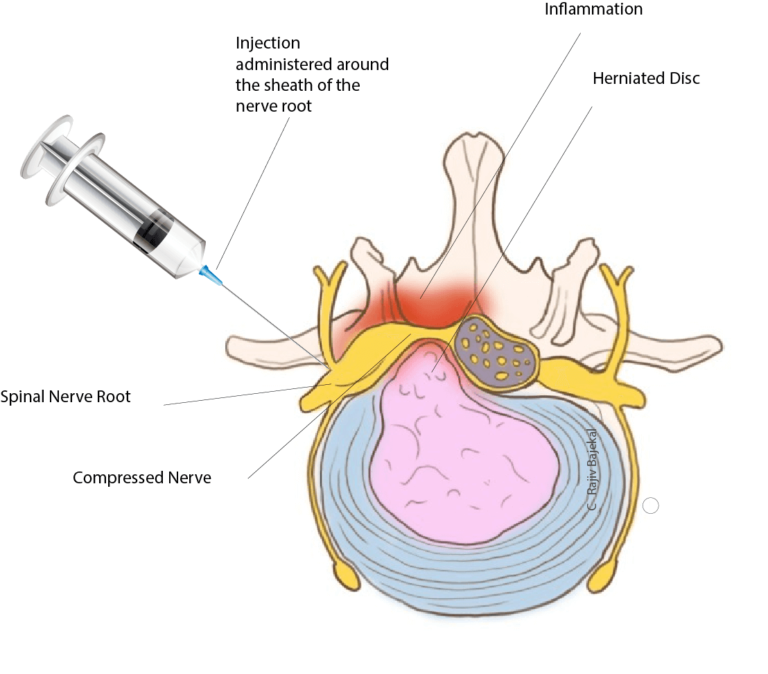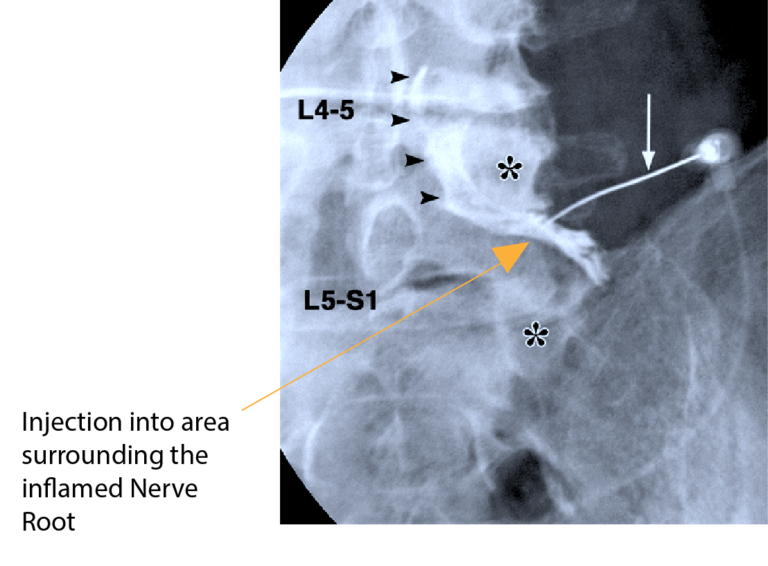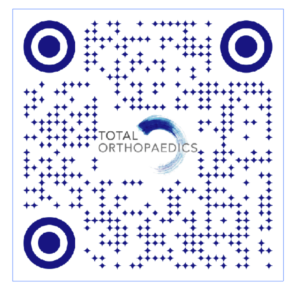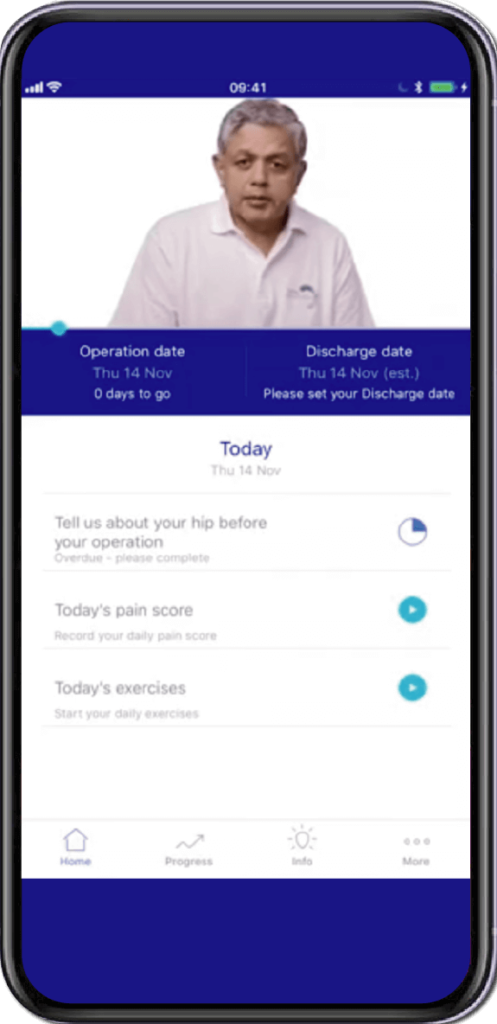
Nerve Root Blocks (NRB)
A nerve root block or transforaminal epidural is a targeted injection administered to relieve pain surrounding a specific set of nerves branching out from the spine.
What are Nerve Root Blocks?
A nerve root block is a targeted injection administered around the affected nerves where the spinal nerve exits the spinal column. It is exceptionally effective in reducing pain due to sciatica. You are sedated for the procedure and the injection is usually not an unpleasant procedure. I use x-ray guidance (fluoroscopy) to ensure accuracy of delivery. The injection consists of a steroid (an anti-inflammatory medication) and lignocaine (an anaesthetic, numbing agent).
How is an NRB or transforaminal epidural administered ?
A NRB or transforaminal epidural is administered around the sheath of the nerve root to reduce the pain due to sciatica.



How should I prepare for the procedure?
The procedure requires about 3-4 hours of hospital stay and is a day case procedure. You must stop all solid food intake for 6 hours before the injection to avoid problems during sedation. Still water is permitted up to 2 hours before. Milky tea, coffee and chewing gum are not permitted for 6 hours before the injection.
You must inform my anaesthetist, the nurse looking after you, preassessment team and me of all the medications you are taking, any allergies that you may have including drug reactions as these can seriously impact your surgery and recovery. Drugs such as aspirin, clopidogrel, and other blood thinners may need to be reviewed or stopped under guidance before surgery. If you are diabetic, especially on insulin, this needs to be highlighted early.
What should I expect at the hospital?
Safety checks ensure that administering the injection to the correct spot and side. Patients undergo a preliminary examination to ensure blood pressure, pulse etc., are within a normal range. We take written consent from the patient and answer any further questions regarding the procedure. You would need to remove your jewellery and makeup and change into hospital issue clothes before the injection. you would also meet the anaesthetist, who will keep you comfortable for the procedure with sedation.
What should I expect during the procedure?
The procedure is performed in the operation theatre or the X-ray department under fluoroscopy. An anaesthetist is in attendance as this procedure takes place under sedation. The anaesthetist inserts a small flexible plastic tube (venflon) through the skin into one of your veins to administer the sedative and additional medications. You may feel very drowsy or may not even remember the event as a result. It is generally not perceived as an unpleasant procedure. I will insert a fine needle under X-ray guidance close to the most inflamed area and inject the steroid combined with a short acting local anaesthetic (lignocaine). The puncture point of the injection is covered with a sealant spray or a small dressing.
X-ray showing NRB or transforaminal epidural being administered
X-ray showing the NRB being administered and the outline of the inflamed nerve root.



What happens after the injection is done?
Immediately after the procedure, you are taken back to the recovery room or the ward. You will be offered a drink and snack. While you can walk shortly after the injection, this is best done with the nurse or physiotherapist nearby. The sedative effect wears off only after a day so. Driving is not permitted for 24 hours.
When can I feel the benefit of the injection?
Pain relief of sciatica can be quite dramatic. The benefit could last long term. The alleviation of pain can start between a few hours to a few days after the injection. The success of a relatively minor injection may prevent the need for surgery.
What are the complications of a nerve root block or transforaminal injection?
Complications are rare after this commonly performed procedure. Sometimes a nerve root block or transforaminal epidural will temporarily worsen your leg pain (steroid flare) because the injection is right next to the nerve root. For some days after the injection, you may require strong pain medication.
The more common problem is that the injection may not help the pain (20%) and this is due to one of three reasons:
- The needle missed the exact spot during injection- this is rare as a live x-ray guides the injection. Individual anatomical variations in patients sometimes offer difficulties during the injection. There may be a need to repeat the injection in such cases.
- The problem may be too severe for an injection to resolve, and surgery might be more advisable (e.g., a rather large disc prolapse)
- Pain returns a few weeks or months after an initial response- a repeat injection may resolve the problem.
Other complications include infections (exceedingly rare) or a flushed face lasting 24 hours (due to preservatives in the medication). Very rarely, some women experience menstrual cycle disturbances, which usually settle after 2-3 cycles. Diabetic control may be disturbed for a few days. Infection is a low risk of this type of injection, as is a cerebrospinal fluid leak.
In the Covid environment, there is a small risk of depression of immunity for a few days, which could make you prone to contracting the virus. Therefore, social distancing is essential post-injection for a few days.
It is best to leave a two-week gap between the injection and the vaccine.
Why get a nerve root block or transforaminal injection?
Pain relief of sciatica can be quite dramatic. The benefit could last long term. The alleviation of pain can start between a few hours to a few days after the injection. The success of a relatively minor injection may prevent the need for surgery. Remember that most disc problems settle with time- the injection allows healing to occur in a relatively pain free environment.
Who should not have a nerve root block?
Pregnant women- there is a risk to the foetus from radiation; therefore, the procedure is not advisable.
If you are on blood thinning medication like clopidogrel, warfarin, aspirin etc. – injections could be dangerous in these situations as a bleed around the nerves could damage the nerve. Do let me know well before hand if you are on such medication, as we may be able to stop it a few days before the injection.
How many times can one have NRBs in a year?
While there is no definitive research dictating the frequency of NRB injections, it is advisable to limit them to three times per year. NRB injections are technically more challenging to perform than epidural steroid injections. Since the injection is outside the spine, there is a minimal risk of a wet tap (cerebrospinal fluid leak). If you require more than three injections, surgery may be a better long-term option for you.
What should I monitor after the injection?
You must keep a ‘pain diary’ and report the approximate percentage of pain relief and record the relief experienced during the next week. Do let Dawn know how you are doing.
What activities and exercise can I do after the injection?
It is best to let pain be your guide to resuming activity and exercise. If you were in a lot of pain before the injection, walking a little more every day is a good starting point. When you feel that 3-4 weeks have gone by without a recurrence of pain, you could consider pilates or physiotherapy to give you more confidence. In general, it is better to avoid impact activities such as running, which may stir up the pain again.
When will I need to be reviewed again?
I usually review you at the 6-week stage in clinic to make a longer time plan with regard to physiotherapy and strengthening of the back etc. If your pain does not get better, I will see you earlier.
I use the myrecovery app to get feedback from patients and data on success rates. You can download the app to your phone here. (https://www.myrecovery.app/rba).
Specially Customised for you
Your version of the app will be customised specifically for you, by your surgeon.
This app will provide you with video messages from your consultant, highlighting key points during your patient journey.
To aid in your recovery process, it will provide you with:
- Interactive exercise plans
- Demonstration videos
- Progress graphs
- Useful articles chosen by your clinical team and more.
This app is in conjunction with Total Orthopaedics. To download the app, please scan in the QR code below:









Rajiv Bajekal is a Consultant Orthopaedic Surgeon with special interest in Spinal and Back-related issues. He has developed a pragmatic approach to managing back pain and sciatica with non-surgical techniques, injections and minimally invasive techniques. Mr Bajekal is also a Board-Certified Lifestyle Medicine Practitioner and believes in providing lifestyle medicine advice to his patients for better long term health gains and better spinal health. He has been consulting since 1998. He consults both privately and on the National Health Service (NHS) and is passionate about making sure patients are in control of their healthcare.
Mr Bajekal is a member of the following institutions:
- British Medical Association (BMA)
- British Association of Spine Surgeons
- British Society of Lifestyle Medicine (BSLM)
- Plant-Based Health Professionals
- Patient Information
- Hospital Practices
- Spire Bushey Hospital
- BMI The Cavell
- BMI The King’s Oak
- Contact
- Blog
- Resources
- Glossary
Additional Links
Mr Bajekal works in conjunction with Total Orthopaedics UK. For more details please click here.
For more detailed information on plant-based nutirition please visit: www.rohinibajekal.com
For more detailed information on women’s health please visit: www.nitubajekal.com
